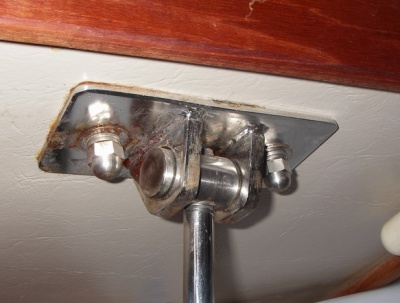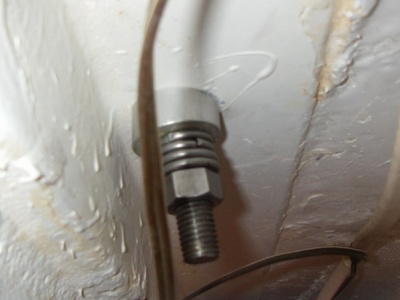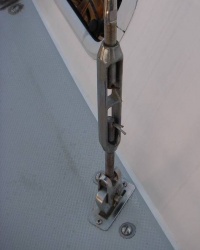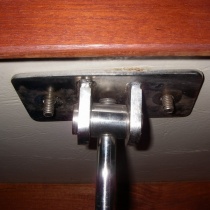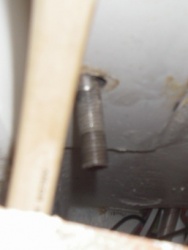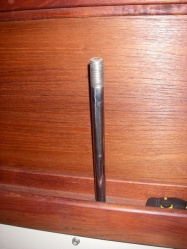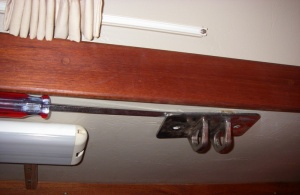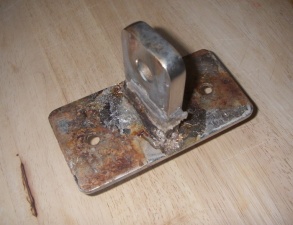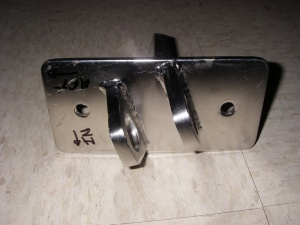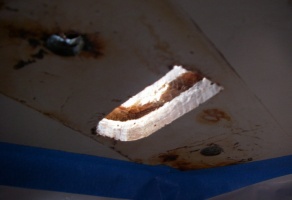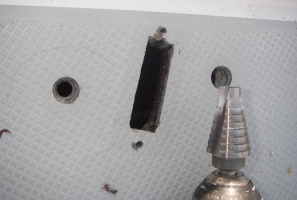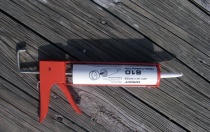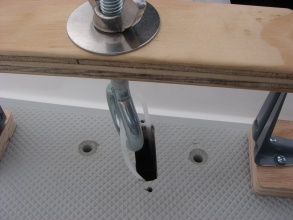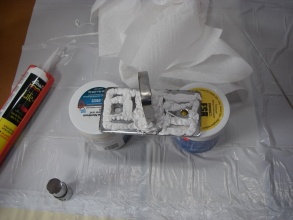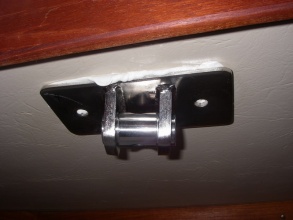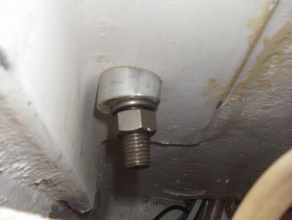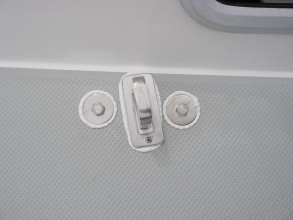Difference between revisions of "Inspecting and Re-bedding Chainplates"
Stu jackson (talk | contribs) |
|||
| (10 intermediate revisions by 4 users not shown) | |||
| Line 1: | Line 1: | ||
| − | '''By Mike Vaccaro, ''Spirit'' #563 (1988) | + | '''By Mike Vaccaro, ''[[Spirit]]'' #563 (1988) |
| Line 8: | Line 8: | ||
The proper bedding material for chain plates is polysulfide. Boatlife Life Caulk or 3M 101 are two readily available examples. The prime benefits of polysulfide are its sealing properties, flexibility when cured and that it is readily removed when it’s time to re-bed in the future. The only down side to polysulfide is the time required for a complete cure—up to 21 days in cold temperatures. Polyurethane adhesive/sealants such as 3M 5200 should not be used as their primary purpose is to adhere, not seal components. Due to flexing and maintenance requirements it WILL be necessary in the future to be able to disassemble the chain plates. Polyether sealants may be used (3M 4000 UV or West Marine Multi-caulk) as can silicone, especially if limited time is available for bedding jobs. | The proper bedding material for chain plates is polysulfide. Boatlife Life Caulk or 3M 101 are two readily available examples. The prime benefits of polysulfide are its sealing properties, flexibility when cured and that it is readily removed when it’s time to re-bed in the future. The only down side to polysulfide is the time required for a complete cure—up to 21 days in cold temperatures. Polyurethane adhesive/sealants such as 3M 5200 should not be used as their primary purpose is to adhere, not seal components. Due to flexing and maintenance requirements it WILL be necessary in the future to be able to disassemble the chain plates. Polyether sealants may be used (3M 4000 UV or West Marine Multi-caulk) as can silicone, especially if limited time is available for bedding jobs. | ||
| + | [2/24/2014 - Stu] NEW material for rebedding chainplates is BUTYL TAPE. http://c34.org/bbs/index.php/topic,7265.0.html | ||
| + | |||
| + | [2/24/2014 - Stu] Do NOT install sealant of ANY kind UNDERNEATH. You NEED to seal the TOP where the water comes from. You WANT to keep the bottom clear so that any water that may come in SHOWS so you'll know it's leaking. | ||
| + | |||
| + | |||
| + | ==== Correction Note ==== | ||
| + | Bill of "Grace Under Pressure" wrote (Nov. 2009): as far as the chain plate rebedding there is what I consider a flaw in the instructions on this website. According to Don Casey's book sailboat hull and deck repair, you need to rebed the chainplates but skip the sealant on the underside of the chainplates inside the cabin. You do not want to seal moisture in the deck. I am not saying that the instructions are not good, they are, just do not seal the underside (cabin) plate. This will allow moisture to enter the cabin when the seal at the chainplate fails - indicating time to reseal or rebed. [Stu] | ||
| + | |||
| + | BUTYL tape has been shown to be a GREAT improvement over silicone sealant. See this Message Board thread: http://c34.org/bbs/index.php/topic,7249.0.html [Stu 12/15/123] | ||
| + | |||
| + | ===Removal=== | ||
This repair is best accomplished with the boat in the water. This will allow the bedding to cure with the chain plates under tension. It’s best to work on the same shroud on both sides of the boat at the same time, i.e., aft lowers, uppers or forward lowers. The first step is to treat your turnbuckles to a spray of lubricant. Then, remove the cotter pins from the bolts. The turn buckle is loosened with two wrenches, one to hold the shroud stationary and the other to turn the turn buckle. Two adjustable wrenches will work. A medium and large type works the best, using the medium wrench to hold the shroud and the large wrench on the center of the turn buckle. It is important not to allow the shroud to twist when loosening the turnbuckle. Only the turn buckle should turn. Turn the turnbuckle for a turn or two and look at the threads to determine if you are tightening or loosening it. When viewed from above, most turnbuckle assemblies are rotated counter-clock wise to loosen. Continue to loosen the turnbuckle until the shroud is slack and you can remove the cotter pin in the clevis pin holding the t-bolt to the chain plate. Disconnect the shroud from the chain plate. | This repair is best accomplished with the boat in the water. This will allow the bedding to cure with the chain plates under tension. It’s best to work on the same shroud on both sides of the boat at the same time, i.e., aft lowers, uppers or forward lowers. The first step is to treat your turnbuckles to a spray of lubricant. Then, remove the cotter pins from the bolts. The turn buckle is loosened with two wrenches, one to hold the shroud stationary and the other to turn the turn buckle. Two adjustable wrenches will work. A medium and large type works the best, using the medium wrench to hold the shroud and the large wrench on the center of the turn buckle. It is important not to allow the shroud to twist when loosening the turnbuckle. Only the turn buckle should turn. Turn the turnbuckle for a turn or two and look at the threads to determine if you are tightening or loosening it. When viewed from above, most turnbuckle assemblies are rotated counter-clock wise to loosen. Continue to loosen the turnbuckle until the shroud is slack and you can remove the cotter pin in the clevis pin holding the t-bolt to the chain plate. Disconnect the shroud from the chain plate. | ||
| Line 18: | Line 29: | ||
| − | <gallery caption="Click any image to enlarge" perrow=3 widths=210px heights= | + | <gallery caption="Click any image to enlarge" perrow=3 widths=210px heights=250px> |
image:chainPlateRepair3.jpg|Chain plate cover and machine screws that hold plate to the bottom of the deck | image:chainPlateRepair3.jpg|Chain plate cover and machine screws that hold plate to the bottom of the deck | ||
| + | |||
image:chainPlateRepair4.jpg|Turnbuckle/shroud removal | image:chainPlateRepair4.jpg|Turnbuckle/shroud removal | ||
| + | |||
image:chainPlateRepair8.jpg|Removing chain plate cover | image:chainPlateRepair8.jpg|Removing chain plate cover | ||
| − | |||
| − | |||
image:chainPlateRepair5.jpg|Remove nuts down below | image:chainPlateRepair5.jpg|Remove nuts down below | ||
| + | |||
image:chainPlateRepair6.jpg|Remove nut, lock washer and angled aluminum washer behind settee and rod | image:chainPlateRepair6.jpg|Remove nut, lock washer and angled aluminum washer behind settee and rod | ||
| + | |||
image:chainPlateRepair7.jpg|Uunscrew the threaded | image:chainPlateRepair7.jpg|Uunscrew the threaded | ||
</gallery> | </gallery> | ||
| Line 39: | Line 52: | ||
| − | + | ===Preparation & cleaning=== | |
Old sealant and any surface corrosion should be cleaned from the plates and components after removal. A combination of steel wool, a wire brush, Scotchbrite, razor scraper, small screw driver and elbow grease will aid with mechanical removal of ALL of the old sealant. Any sealant not removed may prevent proper adhesion of the new bedding compound during re-installation. The plate components should be inspected for any signs of corrosion. Welds should be inspected for any signs of fatigue. Some light pitting as the result of surface corrosion is probably O.K.; but any cracks or fissures should be suspect. Any suspect plates should be replaced. Replacement plates can be obtained from Catalina. You’ll need to specify your hull number, year built and which chain plate when ordering. | Old sealant and any surface corrosion should be cleaned from the plates and components after removal. A combination of steel wool, a wire brush, Scotchbrite, razor scraper, small screw driver and elbow grease will aid with mechanical removal of ALL of the old sealant. Any sealant not removed may prevent proper adhesion of the new bedding compound during re-installation. The plate components should be inspected for any signs of corrosion. Welds should be inspected for any signs of fatigue. Some light pitting as the result of surface corrosion is probably O.K.; but any cracks or fissures should be suspect. Any suspect plates should be replaced. Replacement plates can be obtained from Catalina. You’ll need to specify your hull number, year built and which chain plate when ordering. | ||
| Line 45: | Line 58: | ||
Silicone, polysulfide or polyurethane sealants require mechanical removal. A combination of small screw driver, Scotchbrite and a small stainless steel brush will remove the sealant from the no-skid deck. A 3/8” drill can be used to clean the bolt holes and a combination of files and sand paper will clean the inside of the chain plate cut-out. The wood in the deck laminate should be inspected. If it is the color of normal wood, there is no rot. If it has turned black, but resists probing with a knife or other sharp object, it should be dried out and then treated with CDPE. Even if there is no sign of rot, two coats of CDPE will encapsulate the wood and prevent damage in the future. The inside of the bolt holes should be treated as well as the outboard cover plate screw hole (this will require the use of a syringe to apply the epoxy). | Silicone, polysulfide or polyurethane sealants require mechanical removal. A combination of small screw driver, Scotchbrite and a small stainless steel brush will remove the sealant from the no-skid deck. A 3/8” drill can be used to clean the bolt holes and a combination of files and sand paper will clean the inside of the chain plate cut-out. The wood in the deck laminate should be inspected. If it is the color of normal wood, there is no rot. If it has turned black, but resists probing with a knife or other sharp object, it should be dried out and then treated with CDPE. Even if there is no sign of rot, two coats of CDPE will encapsulate the wood and prevent damage in the future. The inside of the bolt holes should be treated as well as the outboard cover plate screw hole (this will require the use of a syringe to apply the epoxy). | ||
| + | |||
<gallery perrow=2 widths=300px heights=225px> | <gallery perrow=2 widths=300px heights=225px> | ||
| Line 55: | Line 69: | ||
| − | <gallery perrow=2 widths=300px heights= | + | <gallery perrow=2 widths=300px heights=200px> |
image:chainPlateRepair13.jpg|This plate showed signs of minimal leakage. There is some mold in the plywood, but this laminate can be preserved with an application of CDPE. Note the remains of the factory-applied silicone. This silicone held up well for 19-years. | image:chainPlateRepair13.jpg|This plate showed signs of minimal leakage. There is some mold in the plywood, but this laminate can be preserved with an application of CDPE. Note the remains of the factory-applied silicone. This silicone held up well for 19-years. | ||
image:chainPlateRepair14.jpg|The same chain plate after cleaning and two coats of epoxy to seal the wood. | image:chainPlateRepair14.jpg|The same chain plate after cleaning and two coats of epoxy to seal the wood. | ||
</gallery> | </gallery> | ||
| − | |||
| − | |||
| − | + | The first step is to remove as much of the rotten core as practical. This will also help determine the extent of the damage/repair required. After cleaning the rotten wood, a combination of digging with a bent wire (or similar tool) and vacuum should be used to remove rotten material. The next step is to stabilize the remaining wood with CDPE. If damage is limited to a small area, the CDPE can be applied with a syringe and tubing via the cut out and bolt holes. To help the epoxy flow, heat is judiciously applied with a heat gun and the boat can be heeled slightly to aid in the flow out board. The heat will reduce the viscosity of the epoxy, aiding in absorption. Most of the repair will be the result of capillary action as the remaining plywood soaks up the epoxy. Fortunately, this area of the deck can be accessed from below, so if more extensive treatment is required, it is practical to drill into the laminate from the cabin. | |
To properly repair the bolt holes, the holes should be bored over-size, filled with epoxy and re-drilled (3/8”) after the epoxy sets. Due to the laminated nature of the deck core, it’s only necessary to bore through the substrate until you reach the hull liner. | To properly repair the bolt holes, the holes should be bored over-size, filled with epoxy and re-drilled (3/8”) after the epoxy sets. Due to the laminated nature of the deck core, it’s only necessary to bore through the substrate until you reach the hull liner. | ||
| − | + | <gallery perrow=2 widths=300px heights=200px> | |
| − | + | image:chainPlateRepair15.jpg|The rotten plywood core has been removed from the area around the cut-out and the nearest bolt hole using an Allen wrench chucked into an electric drill. Additional material was removed with a small hooked wire. This chain plate was sufficiently corroded to warrant replacement. Probing and tap test indicated that non-repairable core damage was limited to an area within 2-3” of the cut-out. This portion of the core will need to be replaced with thickened epoxy. | |
| + | image:chainPlateRepair16.jpg|Over-boring the bolt holes prior to filling with epoxy. Due to the nature of the laminate, a step-drill was used for this purpose. It is not necessary to drill all the way through, only to the cabin liner. A standard drill bit may be used for this purpose. Note the crazing of the gelcoat around the bolt hole as well as the cracks that go to the cut-out. This is the result of compression and failure of the deck core in this area. | ||
| + | </gallery> | ||
| − | + | <gallery perrow=3 widths=210px heights=150px> | |
| − | + | image:chainPlateRepair17.jpg|Masking the area to contain the epoxy. Rust stains on the liner were cleaned with a combination of Davis FSR, a stainless wire brush and Scotchbrite. | |
| + | image:chainPlateRepair18.jpg|West System caulk tube used to force thickened epoxy into the deck. These inexpensive tubes are purchased empty and the thickened epoxy is then added. It’s important that a method be used to ensure that the epoxy is forced into filling all voids in the laminate. | ||
| + | image:chainPlateRepair19.jpg|Thickened epoxy applied to the voids. Heat is judiciously applied to reduce viscosity—use caution since this quantity of epoxy can generate quite a bit of heat during the curing process. If in doubt, do not apply heat to this type of repair. The epoxy is allowed to fill the cut-out to a level just above where the old plywood was removed. This will need to be cut-out after the repair has set. | ||
| + | </gallery> | ||
| − | + | Each chain plate should be inspected after cleaning for any sign of corrosion or stress fatigue. The simple rule-of-thumb is if in doubt, replace it. Most damage severe enough to warrant replacement will be detectable with the naked eye, but a magnifying glass will go a long way to making an accurate assessment. The pictures below show good examples of a plate that should be discarded. This plate was installed in the forward lower position. It was exposed to long-term leaking. It shows signs of exfoliation corrosion around the forward bolt hole as well as a fatigue stress crack. The corrosion can be noted visually as well as by dragging a finger nail over the suspect area to detect surface imperfection. Due to the corrosive environment caused by the leak, the ability of the plate to withstand stress load is dramatically reduced. The best way to obtain a replacement chain plate or sub-component is to call Garhauer directly (909-981-2364) as they sub-contract fabrication of these fittings for Catalina. You’ll need to provide your hull number and production year so that the proper drawings can be referenced. Ask to speak to Doug. The new plate we ordered for our project fit perfectly. | |
| − | |||
| − | + | <gallery perrow=2 widths=300px heights=275px> | |
| − | + | image:chainPlateRepair20a.jpg|Appearances can be deceptive | |
| − | + | image:chainPlateRepair20b.jpg|Chain plate corrosion and hairline crack warranting replacement | |
| − | + | </gallery> | |
| + | ===Re-bedding & reassembly=== | ||
Once the deck has been repaired or cleaned and sealed as necessary, the next step is to reinstall the chain plates. Before you apply any sealant, dry fit all of the components for proper fit. Replace any suspect hardware. Ensure that when the nuts that secure the bolts will have a minimum of two-three threads exposed AFTER the lock washer has been tightened down. If the bolt/screw is too short, it will be difficult to start the nut if sufficient thread isn’t available. This problem will compound if you are attempting to start a nut with polysulfide oozing through the assembly. If in doubt, too long is better than too short. If circumstances permit, the best 316 grade stainless will likely have to be ordered as most local stores will not stock this grade of hardware. Several good on-line sources exist. The bolts or screws that secure the plate to the deck should use locking hardware, either lock washers or lock nuts. Since there will be plenty of sealant used in assembly, I’ve found the best combination of hardware is a lock washer with a standard 3/8 x 16 nut. After the sealant has been cleaned up and dried, you can finish the end of the bolt/screw with an acorn nut if desired. | Once the deck has been repaired or cleaned and sealed as necessary, the next step is to reinstall the chain plates. Before you apply any sealant, dry fit all of the components for proper fit. Replace any suspect hardware. Ensure that when the nuts that secure the bolts will have a minimum of two-three threads exposed AFTER the lock washer has been tightened down. If the bolt/screw is too short, it will be difficult to start the nut if sufficient thread isn’t available. This problem will compound if you are attempting to start a nut with polysulfide oozing through the assembly. If in doubt, too long is better than too short. If circumstances permit, the best 316 grade stainless will likely have to be ordered as most local stores will not stock this grade of hardware. Several good on-line sources exist. The bolts or screws that secure the plate to the deck should use locking hardware, either lock washers or lock nuts. Since there will be plenty of sealant used in assembly, I’ve found the best combination of hardware is a lock washer with a standard 3/8 x 16 nut. After the sealant has been cleaned up and dried, you can finish the end of the bolt/screw with an acorn nut if desired. | ||
| − | |||
| − | |||
| − | |||
| − | |||
| − | |||
| − | |||
Reassembly sequence is important! If you removed the stainless rod for cleaning and lubrication, you may have to fit that back into the hull before you put in the chain plate. To properly orient the rod, the longer threaded portion goes down with the shorter threaded portion screwing into the pin at the chain plate. On all but the forward plates, it will be necessary to install the pin BEFORE the deck bolts, i.e., during reassembly when the plate is covered with sealant. If you fail to do this, you’ll have to pull a bolt to allow the pin to slip in place after assembly, ruining the seal around that bolt. Dry fit the entire assembly before you add the sealant—you’re less likely to make a messy mistake. | Reassembly sequence is important! If you removed the stainless rod for cleaning and lubrication, you may have to fit that back into the hull before you put in the chain plate. To properly orient the rod, the longer threaded portion goes down with the shorter threaded portion screwing into the pin at the chain plate. On all but the forward plates, it will be necessary to install the pin BEFORE the deck bolts, i.e., during reassembly when the plate is covered with sealant. If you fail to do this, you’ll have to pull a bolt to allow the pin to slip in place after assembly, ruining the seal around that bolt. Dry fit the entire assembly before you add the sealant—you’re less likely to make a messy mistake. | ||
| Line 97: | Line 108: | ||
To re-bed, a liberal coating of sealant should be applied to the top of the plate as well as the area around the weld. The goal is to fill the hole in the deck from the bottom up to ensure an adequate seal. Ensure that you’ve removed the cushions and put down adequate drop cloths or plastic as there will be quite a bit of sealant that is squeezed out during assembly. It will take an entire tube of sealant to properly bed all six plates. It’s worth having an extra on hand to ensure that you don’t run out with half a plate covered in wet sealant. The plates can be installed by one person if you work carefully as you can get adequate access through the open port lights. If you are working alone, it’s easier if you replace the screws with hex head bolts, since it’s much easier to hold on to a wrench than a screwdriver with your arm extended through the open port light. It’s also easier to put the final torque on the nut after the sealant has dried without turning the bolt if you can use a wrench to hold it in place instead of a screw driver. | To re-bed, a liberal coating of sealant should be applied to the top of the plate as well as the area around the weld. The goal is to fill the hole in the deck from the bottom up to ensure an adequate seal. Ensure that you’ve removed the cushions and put down adequate drop cloths or plastic as there will be quite a bit of sealant that is squeezed out during assembly. It will take an entire tube of sealant to properly bed all six plates. It’s worth having an extra on hand to ensure that you don’t run out with half a plate covered in wet sealant. The plates can be installed by one person if you work carefully as you can get adequate access through the open port lights. If you are working alone, it’s easier if you replace the screws with hex head bolts, since it’s much easier to hold on to a wrench than a screwdriver with your arm extended through the open port light. It’s also easier to put the final torque on the nut after the sealant has dried without turning the bolt if you can use a wrench to hold it in place instead of a screw driver. | ||
| + | [[image:chainPlateRepair21.jpg|thumb|300px|Tool used to pull chain plate into place with sealant through the deck. The wing nut is loosened to allow the eye bolt to extend and a nylon zip tie is slipped in place through the hole in the chain plate. The zip tie is then pulled tight and the wing nut fastened to pull the plate into place. There is sufficient room to then insert the bolts from above.]] | ||
To re-install the plates, the first step after dry assembly and fit check is to apply a thick bead of sealant to the bolts under the head and fender washer. The standard washers installed by the factory should be replaced with fender washers to distribute the load over a greater deck area, minimizing chances of compression damage. Some sealant should also be applied to the bolt hole itself. The bolts should then be pressed into place through the deck. Ensure that the nuts are readily available, and insert the plate from below with the bolts protruding through the holes. You can then slide a lock washer into place and hand tighten the nuts while pushing down on the bolt heads from above. Alternatively, you can build an inexpensive tool to pull the chain plate into place using a wing nut and a nylon zip tie. | To re-install the plates, the first step after dry assembly and fit check is to apply a thick bead of sealant to the bolts under the head and fender washer. The standard washers installed by the factory should be replaced with fender washers to distribute the load over a greater deck area, minimizing chances of compression damage. Some sealant should also be applied to the bolt hole itself. The bolts should then be pressed into place through the deck. Ensure that the nuts are readily available, and insert the plate from below with the bolts protruding through the holes. You can then slide a lock washer into place and hand tighten the nuts while pushing down on the bolt heads from above. Alternatively, you can build an inexpensive tool to pull the chain plate into place using a wing nut and a nylon zip tie. | ||
| − | |||
| − | |||
| − | |||
| − | |||
As with any bedding job, the sealant should be allowed to cure before applying final torque to the bolts. Clean up the mess below and attach the threaded rod to the pin in the chain plate. Slip the angle washer into place as well as the lock nuts, and tighten the nut at the base of the rod hand tight. You should then re-attach the turn buckle toggle to the chain plate. Hand tighten the turnbuckle and then return below to tighten the nut at the base of the rod sufficiently to compress the lock washers—this constitutes “just snug” which is the proper torque specification. You can then put a couple of additional turns on the turn buckle to tension the rig. The sealant should cure with the rig under tension. | As with any bedding job, the sealant should be allowed to cure before applying final torque to the bolts. Clean up the mess below and attach the threaded rod to the pin in the chain plate. Slip the angle washer into place as well as the lock nuts, and tighten the nut at the base of the rod hand tight. You should then re-attach the turn buckle toggle to the chain plate. Hand tighten the turnbuckle and then return below to tighten the nut at the base of the rod sufficiently to compress the lock washers—this constitutes “just snug” which is the proper torque specification. You can then put a couple of additional turns on the turn buckle to tension the rig. The sealant should cure with the rig under tension. | ||
| Line 107: | Line 115: | ||
There are several good techniques for masking when bedding deck hardware, but this is complicated if you have an older bolt with textured deck under the fittings. Newer boats have no non-skid molded into the deck area around the chain plates. If bedding over non-skid, the easiest way to clean excess sealant is to simply allow it to ooze out, and then cut it off with a razor blade after it has cured. If you are using polysulfide, you can clean things up easily after it has cured with a small stainless steel brush. Polyurethane and silicone are a bit more challenging and some effort should be made to remove excess when wet and masking will definitely help. | There are several good techniques for masking when bedding deck hardware, but this is complicated if you have an older bolt with textured deck under the fittings. Newer boats have no non-skid molded into the deck area around the chain plates. If bedding over non-skid, the easiest way to clean excess sealant is to simply allow it to ooze out, and then cut it off with a razor blade after it has cured. If you are using polysulfide, you can clean things up easily after it has cured with a small stainless steel brush. Polyurethane and silicone are a bit more challenging and some effort should be made to remove excess when wet and masking will definitely help. | ||
| − | Ensure that adequate time is allowed before you put final tension on the rig and sail the boat. Polysulfide should be given a minimum of one week to cure during warm temperatures and at least 14 days during cooler temperatures. | + | Ensure that adequate time is allowed before you put final tension on the rig and sail the boat. Polysulfide should be given a minimum of one week to cure during warm temperatures and at least 14 days during cooler temperatures. The pictures below illustrate the chain plate installation steps. |
| + | ===Step-by-step installation photos=== | ||
| + | <gallery perrow=2 widths=300px heights=220px> | ||
| + | image:chainPlateRepair22.jpg|Repaired deck ready for chain plate installation. Ensure all surfaces are completely clean and wiped down with acetone or a similar solvent before applying bedding compound. | ||
| − | + | image:chainPlateRepair23.jpg|Positioning the chain plate “puller” and nylon zip tie used to secure the plate to the eyebolt | |
| − | |||
| + | image:chainPlateRepair24.jpg|Applying the bedding compound to the chain plate. The goal is to force the bedding up from the bottom, so be sure to put plenty at the base of the plate. | ||
| − | + | image:chainPlateRepair25.jpg|Securing the chain plate with the zip tie. This can be done with one hand when working carefully. Ensure you slide the end of the zip tie up through the hole so it doesn’t become stuck when you try to pull the plate. [Ed. note: if the "puller tool" had a hook or an "opened eye" verses a closed eye-bolt, then the zip-tie loop could be closed before the chainplate was raised into position. Then feed the loop up through the hole and slip it over the hook.] | |
| − | |||
| + | image:chainPlateRepair26.jpg|Tighten zip tie and eye bolt to pull plate up to deck. | ||
| − | + | image:chainPlateRepair27.jpg|Plate held in place. Note that pin is fitted at this time since it may not be possible to slide it past the bolts once they are inserted. | |
| − | |||
| + | image:chainPlateRepair28.jpg|Prepping the bolts with bedding compound prior to inserting. Note the use of over-sized fender washers to better spread the bolt load to the deck. | ||
| − | + | image:chainPlateRepair29.jpg|Bolts inserted from above the deck. Bedding compound is simply allowed to ooze out. It will be trimmed off with a razor after it has set. | |
| − | |||
| + | image:chainPlateRepair30.jpg|Lock washers and nuts hand tightened, plus one half turn with the wrench. Do not compress the lock washers until the bedding compound has partially cured. | ||
| − | + | image:chainPlateRepair31.jpg|Coat the end of the tie rod with Lanicote and thread into place. Note that the top of the rod just protrudes above the pin. Ensure a minimum of one thread is visible when assembling. | |
| − | |||
| + | image:chainPlateRepair32.jpg|Attach the nut to the base of the tie rod. Ensure that the thick aluminum “washer” is properly oriented. Assembly is hand tight at this point. It will be tightened to “just snug” once the bolts holding the plate have received their final tightening after the bedding has partially cured. | ||
| − | + | image:chainPlateRepair33.jpg|Installed plate and cover. The excess polysulfide bedding is easily removed with a razor blade after it has cured. | |
| − | |||
| + | image:chainPlateRepair34.jpg|Interior view of finished chain plate after excess polysulfide has been cleaned up, post cure. | ||
| − | + | </gallery> | |
| − | |||
| − | |||
| − | |||
| − | |||
| − | |||
| − | |||
| − | |||
| − | |||
| − | |||
| − | |||
| − | |||
| − | |||
| − | |||
| − | |||
| − | |||
| − | |||
| − | |||
| − | |||
| − | |||
| − | |||
| − | |||
| − | |||
| − | |||
| − | |||
Latest revision as of 02:00, 25 February 2014
By Mike Vaccaro, Spirit #563 (1988)
One of the necessary evils of owning a boat is the requirement to re-bed deck hardware from time to time. The C34 has a well-designed chain plate system that effectively transfers the rigging load from the shrouds to the deck and the hull. Unlike many sailboats, the plates are not tied to a bulkhead or any interior wood work. The holes for the plates do, however, pass through the deck which is a sandwich is made up of the hull liner, plywood and the deck laminate. In Mark I boats, the holes were cut and the chain plates installed with bedding compound. The edges of the laminated plywood were left exposed. This is a prime source of water intrusion that can lead to deck rot and delamination. If extensive, this rot requires major structural repair and is best avoided by properly maintaining the bedding compound used to seal the chain plate holes in the deck. The interior chain plate assemblies should be regularly inspected for the presence of leaks. Leaks are evidenced by presence of water, corrosion on plate components or brown staining around the plate assemblies. Water that leaks through the plates is likely to run down the rod assembly and cause water damage to the wood shelving behind the settees.
The proper bedding material for chain plates is polysulfide. Boatlife Life Caulk or 3M 101 are two readily available examples. The prime benefits of polysulfide are its sealing properties, flexibility when cured and that it is readily removed when it’s time to re-bed in the future. The only down side to polysulfide is the time required for a complete cure—up to 21 days in cold temperatures. Polyurethane adhesive/sealants such as 3M 5200 should not be used as their primary purpose is to adhere, not seal components. Due to flexing and maintenance requirements it WILL be necessary in the future to be able to disassemble the chain plates. Polyether sealants may be used (3M 4000 UV or West Marine Multi-caulk) as can silicone, especially if limited time is available for bedding jobs.
[2/24/2014 - Stu] NEW material for rebedding chainplates is BUTYL TAPE. http://c34.org/bbs/index.php/topic,7265.0.html
[2/24/2014 - Stu] Do NOT install sealant of ANY kind UNDERNEATH. You NEED to seal the TOP where the water comes from. You WANT to keep the bottom clear so that any water that may come in SHOWS so you'll know it's leaking.
Contents
Correction Note
Bill of "Grace Under Pressure" wrote (Nov. 2009): as far as the chain plate rebedding there is what I consider a flaw in the instructions on this website. According to Don Casey's book sailboat hull and deck repair, you need to rebed the chainplates but skip the sealant on the underside of the chainplates inside the cabin. You do not want to seal moisture in the deck. I am not saying that the instructions are not good, they are, just do not seal the underside (cabin) plate. This will allow moisture to enter the cabin when the seal at the chainplate fails - indicating time to reseal or rebed. [Stu]
BUTYL tape has been shown to be a GREAT improvement over silicone sealant. See this Message Board thread: http://c34.org/bbs/index.php/topic,7249.0.html [Stu 12/15/123]
Removal
This repair is best accomplished with the boat in the water. This will allow the bedding to cure with the chain plates under tension. It’s best to work on the same shroud on both sides of the boat at the same time, i.e., aft lowers, uppers or forward lowers. The first step is to treat your turnbuckles to a spray of lubricant. Then, remove the cotter pins from the bolts. The turn buckle is loosened with two wrenches, one to hold the shroud stationary and the other to turn the turn buckle. Two adjustable wrenches will work. A medium and large type works the best, using the medium wrench to hold the shroud and the large wrench on the center of the turn buckle. It is important not to allow the shroud to twist when loosening the turnbuckle. Only the turn buckle should turn. Turn the turnbuckle for a turn or two and look at the threads to determine if you are tightening or loosening it. When viewed from above, most turnbuckle assemblies are rotated counter-clock wise to loosen. Continue to loosen the turnbuckle until the shroud is slack and you can remove the cotter pin in the clevis pin holding the t-bolt to the chain plate. Disconnect the shroud from the chain plate.
The next step is to go below and remove the back cushions on the settees to access the bolts at the bottom of the rod. Use a 15/16” wrench to loosen these bolts. A shot of lubricant will help if the bolts have not been loosened. Some boats have two nuts—the lower nut is a lock nut to ensure the upper nut doesn’t back off. Other boats are equipped with multiple lock washers. Be sure that after you loosen these bolts you catch all of the hardware so that it’s not lost in the recesses of the hull. You may or may not be able to slide the aluminum beveled bushing at the top of the assembly. If there has been any leaking, the aluminum may have corroded slightly to the stainless rod. A tap with a hammer will usually be sufficient to loosen this bushing. Each bushing is different; so use care not to mix them up. Also note which side is the top and bottom when you remove it and mark it so that it’s reinstalled properly. If you don’t wish to completely disassemble and lubricate or remove the rod, it’s only necessary to loosen the bolt a bit to allow you twist the rod out of the chain plate fitting.
To remove the rod from the chain plate base, just turn it until it’s loose. This will be easier with a bit of lubricant, a light tap with a hammer and then a non-marring vice grip or channel lock pliers. Use care not to damage the polished stainless rod. After it’s screwed out of the chain plate, allow the rod to slide down to rest on the hull. It is possible to remove the upper and aft rods if you wish to clean them up, but the forward lower rods are difficult to remove unless the teak trim strip below the port lights is removed.
The next step is to go back up on deck and remove the chain plate covers. These are the metal rectangles that surround the base of the chain plate and are held in place with two small #8 ¾” stainless screws. Remove the screws and gently pry the cover off of the deck. It will be necessary to clean the old sealant from the cover after removal. The screws should be replaced with hex head bolts and the standard washers will be replaced with fender washers during reassembly.
- Click any image to enlarge
The last step is to remove the two 3/8” x 16 course threaded machine screws that hold the plate to the deck. This is a one person job as the screws and bolts can be accessed by reaching through open portholes. Once the bolts are removed, the easiest way to pry the plate from the bottom of the deck is to go above and simply stand on the plate to put pressure on it. Apply smooth steady pressure—don’t stomp on it. If you are working alone, be sure to put something below to catch the plate when it falls as it weighs several pounds. After removal, the chain plate components should be disassembled and cleaned.
Preparation & cleaning
Old sealant and any surface corrosion should be cleaned from the plates and components after removal. A combination of steel wool, a wire brush, Scotchbrite, razor scraper, small screw driver and elbow grease will aid with mechanical removal of ALL of the old sealant. Any sealant not removed may prevent proper adhesion of the new bedding compound during re-installation. The plate components should be inspected for any signs of corrosion. Welds should be inspected for any signs of fatigue. Some light pitting as the result of surface corrosion is probably O.K.; but any cracks or fissures should be suspect. Any suspect plates should be replaced. Replacement plates can be obtained from Catalina. You’ll need to specify your hull number, year built and which chain plate when ordering.
Cleaning the deck and chain plate cut-out will require some effort. Our chain plates were installed at the factory with silicone. Of the six plates, only one showed no signs of leaking after twenty years. Five simply required cleaning and a coat of clear, deep-penetrating epoxy (CDPE) to seal the exposed edge of the 3/8” plywood in the deck laminate. One had some rot in the plywood around the bolt holes and cutout which required repair, and this chain plate also exhibited sufficient signs of corrosion to warrant replacement.
Silicone, polysulfide or polyurethane sealants require mechanical removal. A combination of small screw driver, Scotchbrite and a small stainless steel brush will remove the sealant from the no-skid deck. A 3/8” drill can be used to clean the bolt holes and a combination of files and sand paper will clean the inside of the chain plate cut-out. The wood in the deck laminate should be inspected. If it is the color of normal wood, there is no rot. If it has turned black, but resists probing with a knife or other sharp object, it should be dried out and then treated with CDPE. Even if there is no sign of rot, two coats of CDPE will encapsulate the wood and prevent damage in the future. The inside of the bolt holes should be treated as well as the outboard cover plate screw hole (this will require the use of a syringe to apply the epoxy).
Disassembled chain plate components. This is the port aft lower plate from Hull 563 and is a different design than the other five. It has bolts in addition to the weld holding the chain plate to the base. Based on the type and condition of the sealant, it appears that this plate was installed at the factory during production.
If there has been sufficient leaking to allow the plywood core to rot, repair is more problematic. Visual indication of problems may include gel-coat cracking if the upper glass laminate has been stressed by compression. A simple tap test with a hard object will also provide some clue as to the extent of the core damage. Ultimately, a moisture meter will be required if the damage appears to be extensive. The repair described in this article is sufficient if core damage is limited to a small area around the bolt holes and cut-out. An excellent discussion of core repair can be found at www.rotdoctor.com. If there is any doubt about the ability to properly accomplish this type of repair, it’s best to consult a professional.
The first step is to remove as much of the rotten core as practical. This will also help determine the extent of the damage/repair required. After cleaning the rotten wood, a combination of digging with a bent wire (or similar tool) and vacuum should be used to remove rotten material. The next step is to stabilize the remaining wood with CDPE. If damage is limited to a small area, the CDPE can be applied with a syringe and tubing via the cut out and bolt holes. To help the epoxy flow, heat is judiciously applied with a heat gun and the boat can be heeled slightly to aid in the flow out board. The heat will reduce the viscosity of the epoxy, aiding in absorption. Most of the repair will be the result of capillary action as the remaining plywood soaks up the epoxy. Fortunately, this area of the deck can be accessed from below, so if more extensive treatment is required, it is practical to drill into the laminate from the cabin.
To properly repair the bolt holes, the holes should be bored over-size, filled with epoxy and re-drilled (3/8”) after the epoxy sets. Due to the laminated nature of the deck core, it’s only necessary to bore through the substrate until you reach the hull liner.
The rotten plywood core has been removed from the area around the cut-out and the nearest bolt hole using an Allen wrench chucked into an electric drill. Additional material was removed with a small hooked wire. This chain plate was sufficiently corroded to warrant replacement. Probing and tap test indicated that non-repairable core damage was limited to an area within 2-3” of the cut-out. This portion of the core will need to be replaced with thickened epoxy.
Over-boring the bolt holes prior to filling with epoxy. Due to the nature of the laminate, a step-drill was used for this purpose. It is not necessary to drill all the way through, only to the cabin liner. A standard drill bit may be used for this purpose. Note the crazing of the gelcoat around the bolt hole as well as the cracks that go to the cut-out. This is the result of compression and failure of the deck core in this area.
Thickened epoxy applied to the voids. Heat is judiciously applied to reduce viscosity—use caution since this quantity of epoxy can generate quite a bit of heat during the curing process. If in doubt, do not apply heat to this type of repair. The epoxy is allowed to fill the cut-out to a level just above where the old plywood was removed. This will need to be cut-out after the repair has set.
Each chain plate should be inspected after cleaning for any sign of corrosion or stress fatigue. The simple rule-of-thumb is if in doubt, replace it. Most damage severe enough to warrant replacement will be detectable with the naked eye, but a magnifying glass will go a long way to making an accurate assessment. The pictures below show good examples of a plate that should be discarded. This plate was installed in the forward lower position. It was exposed to long-term leaking. It shows signs of exfoliation corrosion around the forward bolt hole as well as a fatigue stress crack. The corrosion can be noted visually as well as by dragging a finger nail over the suspect area to detect surface imperfection. Due to the corrosive environment caused by the leak, the ability of the plate to withstand stress load is dramatically reduced. The best way to obtain a replacement chain plate or sub-component is to call Garhauer directly (909-981-2364) as they sub-contract fabrication of these fittings for Catalina. You’ll need to provide your hull number and production year so that the proper drawings can be referenced. Ask to speak to Doug. The new plate we ordered for our project fit perfectly.
Re-bedding & reassembly
Once the deck has been repaired or cleaned and sealed as necessary, the next step is to reinstall the chain plates. Before you apply any sealant, dry fit all of the components for proper fit. Replace any suspect hardware. Ensure that when the nuts that secure the bolts will have a minimum of two-three threads exposed AFTER the lock washer has been tightened down. If the bolt/screw is too short, it will be difficult to start the nut if sufficient thread isn’t available. This problem will compound if you are attempting to start a nut with polysulfide oozing through the assembly. If in doubt, too long is better than too short. If circumstances permit, the best 316 grade stainless will likely have to be ordered as most local stores will not stock this grade of hardware. Several good on-line sources exist. The bolts or screws that secure the plate to the deck should use locking hardware, either lock washers or lock nuts. Since there will be plenty of sealant used in assembly, I’ve found the best combination of hardware is a lock washer with a standard 3/8 x 16 nut. After the sealant has been cleaned up and dried, you can finish the end of the bolt/screw with an acorn nut if desired.
Reassembly sequence is important! If you removed the stainless rod for cleaning and lubrication, you may have to fit that back into the hull before you put in the chain plate. To properly orient the rod, the longer threaded portion goes down with the shorter threaded portion screwing into the pin at the chain plate. On all but the forward plates, it will be necessary to install the pin BEFORE the deck bolts, i.e., during reassembly when the plate is covered with sealant. If you fail to do this, you’ll have to pull a bolt to allow the pin to slip in place after assembly, ruining the seal around that bolt. Dry fit the entire assembly before you add the sealant—you’re less likely to make a messy mistake.
To re-bed, a liberal coating of sealant should be applied to the top of the plate as well as the area around the weld. The goal is to fill the hole in the deck from the bottom up to ensure an adequate seal. Ensure that you’ve removed the cushions and put down adequate drop cloths or plastic as there will be quite a bit of sealant that is squeezed out during assembly. It will take an entire tube of sealant to properly bed all six plates. It’s worth having an extra on hand to ensure that you don’t run out with half a plate covered in wet sealant. The plates can be installed by one person if you work carefully as you can get adequate access through the open port lights. If you are working alone, it’s easier if you replace the screws with hex head bolts, since it’s much easier to hold on to a wrench than a screwdriver with your arm extended through the open port light. It’s also easier to put the final torque on the nut after the sealant has dried without turning the bolt if you can use a wrench to hold it in place instead of a screw driver.
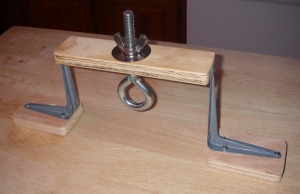
To re-install the plates, the first step after dry assembly and fit check is to apply a thick bead of sealant to the bolts under the head and fender washer. The standard washers installed by the factory should be replaced with fender washers to distribute the load over a greater deck area, minimizing chances of compression damage. Some sealant should also be applied to the bolt hole itself. The bolts should then be pressed into place through the deck. Ensure that the nuts are readily available, and insert the plate from below with the bolts protruding through the holes. You can then slide a lock washer into place and hand tighten the nuts while pushing down on the bolt heads from above. Alternatively, you can build an inexpensive tool to pull the chain plate into place using a wing nut and a nylon zip tie.
As with any bedding job, the sealant should be allowed to cure before applying final torque to the bolts. Clean up the mess below and attach the threaded rod to the pin in the chain plate. Slip the angle washer into place as well as the lock nuts, and tighten the nut at the base of the rod hand tight. You should then re-attach the turn buckle toggle to the chain plate. Hand tighten the turnbuckle and then return below to tighten the nut at the base of the rod sufficiently to compress the lock washers—this constitutes “just snug” which is the proper torque specification. You can then put a couple of additional turns on the turn buckle to tension the rig. The sealant should cure with the rig under tension.
There are several good techniques for masking when bedding deck hardware, but this is complicated if you have an older bolt with textured deck under the fittings. Newer boats have no non-skid molded into the deck area around the chain plates. If bedding over non-skid, the easiest way to clean excess sealant is to simply allow it to ooze out, and then cut it off with a razor blade after it has cured. If you are using polysulfide, you can clean things up easily after it has cured with a small stainless steel brush. Polyurethane and silicone are a bit more challenging and some effort should be made to remove excess when wet and masking will definitely help.
Ensure that adequate time is allowed before you put final tension on the rig and sail the boat. Polysulfide should be given a minimum of one week to cure during warm temperatures and at least 14 days during cooler temperatures. The pictures below illustrate the chain plate installation steps.
Step-by-step installation photos
Securing the chain plate with the zip tie. This can be done with one hand when working carefully. Ensure you slide the end of the zip tie up through the hole so it doesn’t become stuck when you try to pull the plate. [Ed. note: if the "puller tool" had a hook or an "opened eye" verses a closed eye-bolt, then the zip-tie loop could be closed before the chainplate was raised into position. Then feed the loop up through the hole and slip it over the hook.]
